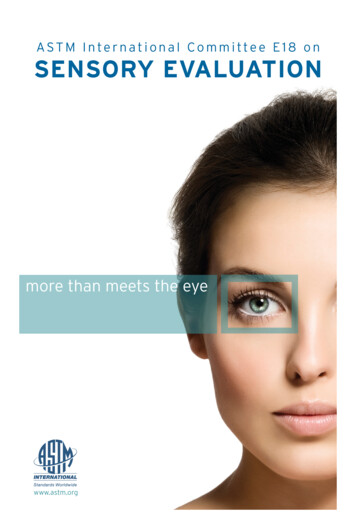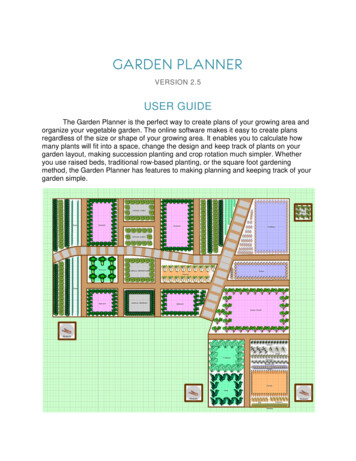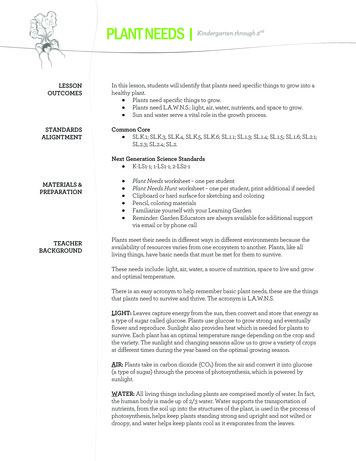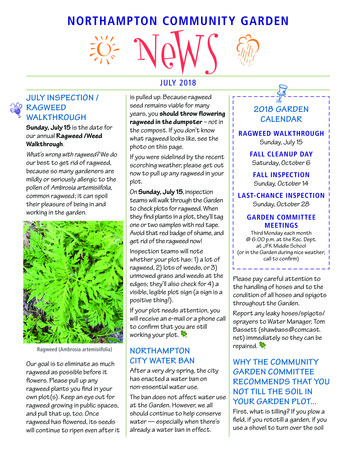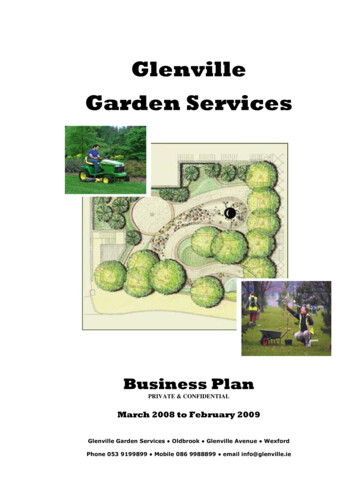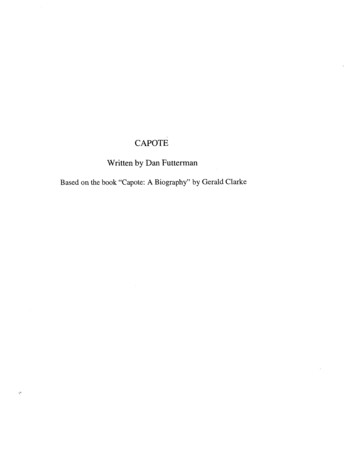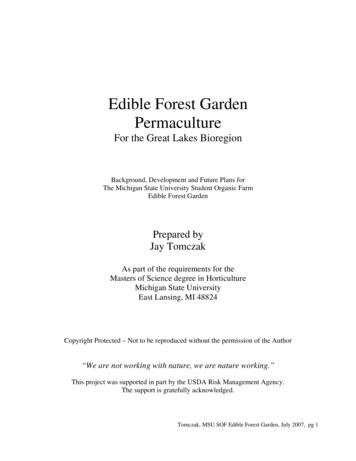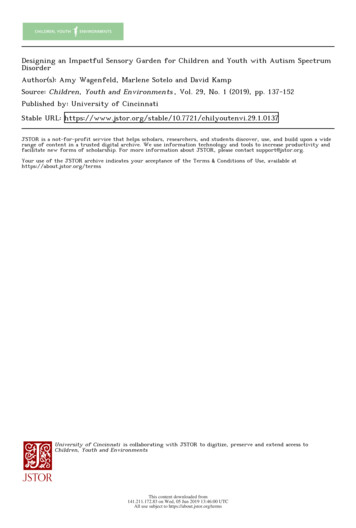
Transcription
Designing an Impactful Sensory Garden for Children and Youth with Autism SpectrumDisorderAuthor(s): Amy Wagenfeld, Marlene Sotelo and David KampSource: Children, Youth and Environments , Vol. 29, No. 1 (2019), pp. 137-152Published by: University of CincinnatiStable URL: 29.1.0137JSTOR is a not-for-profit service that helps scholars, researchers, and students discover, use, and build upon a widerange of content in a trusted digital archive. We use information technology and tools to increase productivity andfacilitate new forms of scholarship. For more information about JSTOR, please contact support@jstor.org.Your use of the JSTOR archive indicates your acceptance of the Terms & Conditions of Use, available athttps://about.jstor.org/termsUniversity of Cincinnati is collaborating with JSTOR to digitize, preserve and extend access toChildren, Youth and EnvironmentsThis content downloaded from141.211.172.83 on Wed, 05 Jun 2019 13:46:00 UTCAll use subject to https://about.jstor.org/terms
Children, Youth and Environments 29(1), 2019Designing an Impactful Sensory Garden forChildren and Youth with Autism Spectrum DisorderAmy WagenfeldDepartment of Occupational Therapy, Johnson & Wales Universitydesign cOnsulTationMarlene SoteloEls for Autism FoundationDavid KampDirtworks Landscape ArchitectureCitation: Wagenfeld, A., Sotelo, M., & Kamp, D. (2019). Designing an impactfulsensory garden for children and youth with Autism Spectrum Disorder.Children, Youth and Environments, 29(1), 137-152. Retrieved urnalCode chilyoutenviAbstractInteracting with nature is understood to improve physical, sensory, social, andemotional wellbeing. With a significant rise in diagnosis of autism spectrumdisorder, now more than ever it is important to provide these children and youthwith carefully designed outdoor environments that meet their unique needs andincrease the meaningfulness of their daily lives. This report describes thedevelopment and features of a newly installed sensory garden at The Els Center ofExcellence in Florida.Keywords: autism spectrum disorder, sensation, garden, learning, autonomy 2019 Children, Youth and EnvironmentsThis content downloaded from141.211.172.83 on Wed, 05 Jun 2019 13:46:00 UTCAll use subject to https://about.jstor.org/terms
Designing an Impactful Sensory Garden for Children and Youth with Autism 138IntroductionAutism spectrum disorder (ASD) represents a range of developmental disabilitiesthat may manifest as significant deficits in social communication; restrictive,repetitive, or stereotypical behaviors; atypical responses to sensory input; andbehavioral challenges (American Psychiatric Association, 2013). These challengesmay lead to difficulties with social relationships, academic proficiency, and/oroccupational performance (American Psychiatric Association, 2013). While it isunderstood that the disorder has a biological component and genetics plays a rolein its familial prevalence, there is no marker or test for diagnosis. Instead, adiagnosis of ASD is made on the basis of parent report and clinical observation(Norbury & Sparks, 2013).Autism spectrum disorder impacts all socioeconomic, racial, and ethnic groups (Baioet al., 2018). There has been a significant increase in the frequency of ASDdiagnosis. In 2000, the ASD prevalence rate in the U.S. was 1 in 150 (about 6.7 per1000), while the current rate is 1 in 40 (Kogan et al., 2018). Boys are over fourtimes more likely to be diagnosed than girls, a rate of 1 in 42 compared to 1 in 189for girls (Baio, 2014). In regions such as Europe, Asia, and North America, studieshave found the prevalence of ASD to be between 1 and 2 percent of the generalpopulation (Centers for Disease Control and Prevention, 2016). Autism spectrumdisorder is the fastest-growing serious developmental disability in the U.S. (AutismSpeaks, 2012).Understanding the ConcernsWithin the autism community it is generally understood that if you meet one personwith autism, you have met one person with autism. That is, while many commoncharacteristics are shared, how many and the severity of each characteristic varieswithin each individual. Individuals typically experience challenges withcommunication and social interactions. Some with ASD have a limited spokenvocabulary, others have none, and yet others speak prolifically. Cognitivelimitations are common and motor skills may also be impaired.Many individuals with ASD experience sensory integration challenges. Sensationrefers to incoming information from the environment such as the smell of roses orthe sound of a drone. Integration is the interpretation of and use of sensoryinformation. For most people, roses smell good while listening to the sound of alawn mower is a minor distraction that is noted then ignored. Intact sensoryintegration enables humans to more or less effortlessly go about their daily liveswith little interruption. Serious and persistent problems with sensory integrationmay lead to a diagnosis of sensory processing disorder, which may be thought of asa disorganized nervous system. It may be challenging to process sensory cues fromthe environment, including sound, sight, smell, taste, touch, balance, andmovement while simultaneously maintaining emotional regulation (Tomchek, Little,& Dunn, 2015). This means that remaining composed and focused on tasks may bevery hard because the sensory systems are not processing in a typical manner.Some individuals with ASD may avoid certain sensory experiences, while some mayseek them out. They may react negatively to certain sound frequencies, to noise,lighting, movement, or touch, or may perseveratively engage in obtaining them.This content downloaded from141.211.172.83 on Wed, 05 Jun 2019 13:46:00 UTCAll use subject to https://about.jstor.org/terms
Designing an Impactful Sensory Garden for Children and Youth with Autism 139A garden may be a buffer to the varied challenges that individuals with ASDexperience (Sachs & Vincenta, 2011). Gardens can provide children with importantproductive and holistic opportunities to be outside and exercise, socialize, learn,nurture their sensory systems, and improve their health. All children, regardless ofskill or ability, deserve and need to participate in outdoor activities. In this fieldreport we identify how challenges for children with ASD were addressed throughdesign and installation of a sensory garden and the children’s response to it.The Sensory Arts Garden at The Els Center of ExcellenceThe Sensory Arts Garden at The Els Center of Excellence is purposely designed forindividuals with ASD and the community of parents, educators, therapists, andcaretakers that support and enrich their lives. The Center, located in Jupiter,Florida, is committed to helping individuals with ASD realize their full potential tolead positive, productive, and rewarding lives though world-class educational,recreational, and therapeutic programming. The new garden opened in late 2017and was designed by a collaboration between landscape architect David Kamp,President of Dirtworks, PC and his design team; Marlene Sotelo, a music therapist,special educator, and the Chief Operating Officer (COO) for the Els for AutismFoundation at The Els Center of Excellence; and Amy Wagenfeld, an occupationaltherapist, educator, and researcher with expertise in therapeutic outdoor spacedesign. Grounded in interdisciplinary research and collaboration, the gardenexpands The Center’s program into a vibrant outdoor setting, celebrating individualstrengths and preferences, and positioning nature as an essential partner in healthand wellness. This unique collaboration also helped balance meeting the specialneeds of individuals with ASD while simultaneously welcoming the largercommunity.This content downloaded from141.211.172.83 on Wed, 05 Jun 2019 13:46:00 UTCAll use subject to https://about.jstor.org/terms
Designing an Impactful Sensory Garden for Children and Youth with Autism 140Figure 1. Enclosed by a verdant planted perimeter, the overall layout offersclear circulation, distinct settings, and well-defined destinations.Source: all images are credited to Dirtworks, PCThis content downloaded from141.211.172.83 on Wed, 05 Jun 2019 13:46:00 UTCAll use subject to https://about.jstor.org/terms
Designing an Impactful Sensory Garden for Children and Youth with Autism 141Figure 2. Diverse sensory experiences, clear circulation and form, andaccommodation for a range of abilities makes for a garden thathonors individual strengths and preferences, reduces stress andanxiety, and encourages social engagement.This content downloaded from141.211.172.83 on Wed, 05 Jun 2019 13:46:00 UTCAll use subject to https://about.jstor.org/terms
Designing an Impactful Sensory Garden for Children and Youth with Autism 142With meticulous attention to detail and thoughtful arrangement of plants, materials,furnishings, and spaces, the garden balances a range of stimulating and calmingsensory experiences intended to allay stress and anxiety and gently elevate thesenses—sight, smell, touch, taste, sound, as well as sense of balance (vestibular)and position and movement in space (proprioception). The 13,000-square footgarden refuge offers a nurturing, sensory-rich, environmentally sensitivetherapeutic setting that supports children and youth with ASD by providingopportunity to work, play, socialize, and learn in the space. Serenity, security, andrestoration are the foundation of the design, thus honoring individual strengths andpreferences, addressing the realities of hypo- and hypersensitivities, fosteringcuriosity and meaningful interactions, and most importantly, welcoming allregardless of ability.This is reinforced by our users. A parent shared, “My son, Andrew, loves the swingin the one of the Places Away so much, we bought one for him to enjoy at home aswell. One of his rewards for working in his classroom is to go out into the SensoryGarden for a break – he always makes a beeline for the swing!” A staff membersaid, “The garden is a place of peace and tranquility. It is space that I go to inmoments when I need to stop, think, breathe and reset my intention for the day. Itis truly a gift.” Although unable to express himself with words, it is evident fromstudent Colin’s body language and affect that he loves to be on campus and in thegarden, particularly when doing yoga.Figure 3. Reduced and integrated sensory spaces provide refuge whenexperiencing sensory overload. Each space features seatingoptions to acknowledge personal choice.This content downloaded from141.211.172.83 on Wed, 05 Jun 2019 13:46:00 UTCAll use subject to https://about.jstor.org/terms
Designing an Impactful Sensory Garden for Children and Youth with Autism 143Figure 4. A grid of foxtail palms offers repetitive visual structure andbrings comfort and clarity of expectations.Figure 5. A spacious curved trellis serves as a welcoming transition fromthe lower school building, campus courtyard, and the front of thecampus. The activity space, an oval “lawn” of artificial turf,features a variety of fixed and movable seating.This content downloaded from141.211.172.83 on Wed, 05 Jun 2019 13:46:00 UTCAll use subject to https://about.jstor.org/terms
Designing an Impactful Sensory Garden for Children and Youth with Autism 144Figure 6. Safety and security are reflected in the overall design, details,and material selections.Designing any environment, inside or out, is enhanced when a team of highlyspecialized interventionists work together (Wagenfeld & Winterbottom, 2015). Forthis garden design to successfully address the breadth and complexity of ASD, theproject necessitated a particularly close collaboration between the landscapearchitect, the Center’s COO, and an occupational therapist. The outcome of thisinterdisciplinary partnership reflects a nuanced response to the varied experiencesof those with ASD while balancing the programming needs of a vibrant and growingteaching and therapeutic facility. This partnership began with a series of tours.Multiple walks around The Center’s campus, accompanied by the COO, engendereda deeper understanding of the needs of this special population for the landscapearchitect. These immersive experiences enabled ideas to flow on how to create agarden that could meet the unique needs of its varying visitors. For instance, duringone tour, the COO provided an anecdote regarding the need for hula-hoops on TheCenter’s golf course during golf group instruction to help the children know whereto wait and stand until it was their turn. From this emerged the concept of gardenrings as boundaries or markers, which is also reinforced in the classrooms whereinstructors use small carpet squares for children to sit on.Considerations for routine, pattern, sightlines, and wayfinding inform the overallgarden form; the garden also preserves a degree of openness that promotescontinued discovery, autonomy, and flexible use. Easy transitions, clear circulationpatterns and destinations, and deceptively simple geometries make for acomprehensible and inviting space for the children and youth. By offering a place topause before entering and take in unobstructed views of the space in its entirety,This content downloaded from141.211.172.83 on Wed, 05 Jun 2019 13:46:00 UTCAll use subject to https://about.jstor.org/terms
Designing an Impactful Sensory Garden for Children and Youth with Autism 145the garden’s entry portals allay potential fears of the unknown or anxiety aboutwhat to expect of a garden visit. A verdant, planted perimeter encloses the spaceand focuses attention within the garden. Overhead, a uniform canopy of foxtailpalms offers a structural rhythm, calming enclosure, and relief from the sun.The designers carefully considered every plant, material, and furnishing for itsappropriateness, safety, durability, and therapeutic potential. “Sensory rooms,”aligned on the garden’s axis, discretely target each of the five senses and featurecustomized lightweight fiberglass planters—a material that reduced cost andprecluded the need for heavy equipment on the small site. The planters’ varyingheights bring a rich variety of sensory-appropriate plants to a comfortable andeasily accessed position for visitors big and small, mobile and seated. Each room isringed by a dark band in the pavement, forming a subtle visual boundary andsignaling a change in sensory experience. Small, movable, musical sculpturesactivate these spaces with sound. Teachers and therapists reposition theinstruments at their discretion to encourage cooperative exchanges or to support anindividual’s creative explorations.Figure 8. “Sensory rooms” discretely target the five senses. Each room,framed by a distinctive paving band, features curved varyingheight custom planters, bringing a rich variety of sensoryappropriate plants within comfortable and easy access.This content downloaded from141.211.172.83 on Wed, 05 Jun 2019 13:46:00 UTCAll use subject to https://about.jstor.org/terms
Designing an Impactful Sensory Garden for Children and Youth with Autism 146Figure 9. Metal chimes, located on opposite sides of a planter, createopportunities for a musical dialogue in one of the sensory rooms.Figure 10. The suite of musical sculptures enriches the tactile and auditorytextures of the garden.This content downloaded from141.211.172.83 on Wed, 05 Jun 2019 13:46:00 UTCAll use subject to https://about.jstor.org/terms
Designing an Impactful Sensory Garden for Children and Youth with Autism 147A series of reduced and integrated sensory spaces, or “places away,” along thegarden perimeter provide calming counterpoints for those who may experiencehypersensitivity or seek a moment of respite and refuge. To enhance feelings ofserenity and tranquility, the planting palette within these spaces is purposelymuted. Structured, trunk-supporting, straight-backed benches with armrestsprovide structure in key areas as well as opportunities to strengthen abdominal andupper body postural muscles. Pebble seats offer a playful alternative and varyinglevels of proprioceptive and vestibular experience. Outdoor furniture is purposelylocated to encourage social interactions in some areas while offering privacy andrespite in others. Water spheres provide rich sensory experiences including touch,sight, sound, and proprioceptive and vestibular input. Their placement, low to theground and tucked into planting beds, require squatting, reach, and balance toaccess. Smooth and rigid surfaces offer varied tactile engagement. All furnishingsare secured to foundations to prevent movement or tipping, and to comply with theSouth Florida hurricane preparedness code. A simple ground plane unifies thespace, while changes in color or material at key points signal a transition, a newexperience, or bring one’s focus towards the body and senses. Insertions of largepebble pavers heighten tactile engagement, proprioception, and gross motor skillsin key areas. Encircling paving bands in other areas mimic the hula hoop concept ofpositioning children within a ring or circle. Like in the classrooms, these visual andtactile boundaries provide consistency, structure, and organization and enablegreater independence, clearer expectations, and richer engagement in theenvironment.Figure 11. Water spheres provide many sensory experiences.This content downloaded from141.211.172.83 on Wed, 05 Jun 2019 13:46:00 UTCAll use subject to https://about.jstor.org/terms
Designing an Impactful Sensory Garden for Children and Youth with Autism 148Figure 12. A small “lawn” encircled by a paving band provide visual cues,signaling changes in sensory experience and activity. Thegarden’s deceptively simple layout accommodates a variety ofneeds: solitude and socialization, calming respite and activity,focused interest, and simple distractions.Figure 13. Structured, upper body supporting, straight-backed benchesprovide stability while “pebble” seats offer a playful alternativeand varying levels of proprioceptive and vestibular experiences.This content downloaded from141.211.172.83 on Wed, 05 Jun 2019 13:46:00 UTCAll use subject to https://about.jstor.org/terms
Designing an Impactful Sensory Garden for Children and Youth with Autism 149Figure 14. A small group gathering space within a ring is orientating andfocusing. A muted planting pallet enhances feelings of serenityand tranquility.The planting strategy was deliberately shaped through a melding of salutogenic,health-promoting design principles and a deep understanding of the unique needsof children and youth with ASD. All materials were thoroughly vetted for toxicityconcerns and an environmentally sensitive coordinated maintenance programinsures that chemicals are used only as a last resort. Trees, such as a gumbo limboand a bay rum were selected for their structural qualities—limb structure, shape,and shade capacity, visual, olfactory, and tactile features, and semi-permeability forclear sight lines within the garden. Repeated patterns of planting provide the justright amount of consistency balanced with interest and mystery to which individualswith ASD tend to respond in a positive manner.Safety and security, the thread that unites all other considerations, are reflected inthe overall design, details, and material selections. Smooth and consistent surfaces,strong and durable materials, and design that eliminates awkward corners addressthe potential for collisions and adverse reactions. Careful selection and placementof plant materials promote safety and minimize negative sensory responses, whilesimultaneously allowing staff and family members to observe the children at adistance as they independently discover the garden.Obstacles and SolutionsWe encountered some unanticipated design challenges and obstacles while creatingthe Sensory Arts Garden, a few of which are described below, along with oursolutions.This content downloaded from141.211.172.83 on Wed, 05 Jun 2019 13:46:00 UTCAll use subject to https://about.jstor.org/terms
Designing an Impactful Sensory Garden for Children and Youth with Autism 150 We needed to balance ASD-specific design elements with making the gardenappropriate and engaging for the general public. In addition, the varied agesof individuals accessing the garden posed challenges in planning for a designto support appropriate activities, furniture size, and purpose.o Solution: Multiple meetings and maintaining open communicationbetween all team members. Good listening was essential. We needed to consider how enticing the water features might be for thechildren.o Solution: A green buffer of plants and river rocks wide enough toprevent full immersion, yet narrow enough to welcome touching ringthe water features. The swing has proven to be so popular that the children wore a trenchbeneath it from pumping their feet to activate it.o Solution: Backfill the trench with soil and fasten a large rectangle ofartificial turf beneath the swing. As the turf wears out, it will be asimple fix to replace. The lemon verbena has become such a child favorite that it literally degradesfrom curious fingers. We also noted frequent pulling of pieces off the pottedglory bush plants and soft to the touch cacti for a bit of enjoyable tactilestimuli on the go. Similarly, one child was found to be repeatedly relocating aclump of holly fern planted nearby the swing. Maintenance staff replaced it,only to find it moved yet again.o Solution: Plan for replacement in the maintenance budget. As needed(all) plants get replaced, and sometimes relocated.ImplicationsIn establishing a vibrant outdoor living classroom, an enriching therapeuticenvironment, and an inclusive, welcoming space for all, the Sensory Arts Gardenfurther advances The Center’s position as a leader in the field, and broadens theirinfluence within the ASD community. It serves to promote the value, acceptance,and inclusion of individuals with ASD as well as offer a destination for social andcommunity events. The garden extends invitations for children to feel whole andsafe on their own terms—to be part of something bigger than themselves withoutfeeling overwhelmed. Since its opening, the children have found reprieve in thegarden’s “places away” and enrichment through exploration of the plants in thesensory rooms. Children have identified favorite spots within the garden and returndaily to engage with these spaces, exploring their subtle changes and new growth.The garden is now an established space for outdoor instruction, providingopportunities to connect with students who may be challenging to reach inside theclassroom. High school students can be found working independently on theirlaptops or with a teaching assistant on classroom assignments. Music and yogaclasses and reading groups have all benefited from this sensory-rich, livingclassroom that welcomes all regardless of age, ability, or preference. Within a lushThis content downloaded from141.211.172.83 on Wed, 05 Jun 2019 13:46:00 UTCAll use subject to https://about.jstor.org/terms
Designing an Impactful Sensory Garden for Children and Youth with Autism 151and safe setting, the garden provides opportunity and choice for everyone toengage with nature on their own terms, in their own way, and at their own pace.From quiet and serene reflection by the water bubblers, to active sensoryinvolvement on the swing, or smelling and tasting herbs found in the sensoryrooms, the garden offers various opportunities for participation including providinga venue for vocational training for the older students and clients of the Foundation.Everyone takes from the garden what they need and want.Research to evaluate the impact of experiencing the garden and attentionalbehaviors is planned. Findings may contribute to the growing body of evidencesupporting the global positive impact of interaction with nature and healthydevelopment.Amy Wagenfeld, Ph.D., OTR/L, SCEM, FAOTA is Associate Professor and CapstoneCoordinator in the Occupational Therapy Doctorate Program Johnson & WalesUniversity and is Principal of design cOnsulTationMarlene Sotelo, Ed.D. BCBA-D, MT-BC is the Chief Operating Officer for the Els forAutism FoundationDavid Kamp, FASLA, LF, NA is President of Dirtworks, PCReferencesAmerican Psychiatric Association (2013). Diagnostic and statistical manual ofmental disorders (5th ed.). Arlington, VA: American Psychiatric Publishing.Autism Speaks (2012). Facts about autism. Retrieved about-autismBaio, J., Wiggins, L., Christensen, D. L., Maenner, M. J., Daniels, J . & Dowling, N.F. (2018). Prevalence and characteristics of autism spectrum disorder amongchildren aged 8 years — Autism and Developmental Disabilities MonitoringNetwork, 11 sites, United States, 2014. MMWR Surveillance Summaries67(6), 1–23. http://dx.doi.org/10.15585/mmwr.ss6706a1Baio, J. (2014). Prevalence of autism spectrum disorders among children aged 8years. Surveillance Summaries 63(SS03), 1—21. Retrieved rs for Disease Control and Prevention (2018). Autism spectrum disorder: Dataand statistics. Retrieved from http://www.cdc.gov/ncbddd/autism/index.htmlCenters for Disease Control and Prevention (2016). Summary of autism spectrumdisorder (ASD) prevalence studies. Retrieved fromThis content downloaded from141.211.172.83 on Wed, 05 Jun 2019 13:46:00 UTCAll use subject to https://about.jstor.org/terms
Designing an Impactful Sensory Garden for Children and Youth with Autism PrevalenceDataTable2016.pdfKogan, M. D., Vladutiu, C. J., Schieve, L. A., Ghandour, R. M., Blumberg, S. J. Lu,M. C. (2018). The prevalence of parent-reported autism spectrum disorderamong US children. Pediatrics, 142(6), rbury, C. F., & Sparks, A. (2013). Difference or disorder: Cultural issues inunderstanding neurodevelopmental disorders. Developmental Psychology,49, 45-58. http://dx.doi.org/10.1037/a0027446Sachs, N., & Vincenta, T. (2011). Outdoor environments for children with autismand special needs. Implications, 9(1), 1-8.Tomchek, S. D., Little, L. M., & Dunn, W. (2015). Sensory pattern contributions todevelopmental performance in children with autism spectrum disorder.American Journal of Occupational Therapy, 69, enfeld, A. & Winterbottom, D. (2015). Interprofessional collaboration:Designing outdoor environments though landscape architecture andoccupational therapy. EDRA Connections, 5-7.Websites Autism Speaks: http://www.autismspeaks.orgAutism Society: http://www.autism-society.orgEls for Autism: llence/National Autism Society- Signs of ces/signs-of-autism/This content downloaded from141.211.172.83 on Wed, 05 Jun 2019 13:46:00 UTCAll use subject to https://about.jstor.org/terms
Els for Autism Foundation David Kamp Dirtworks Landscape Architecture Citation: Wagenfeld, A., Sotelo, M., & Kamp, D. (2019). Designing an impactful sensory garden for children and youth with Autism Spectrum Disorder. Children
